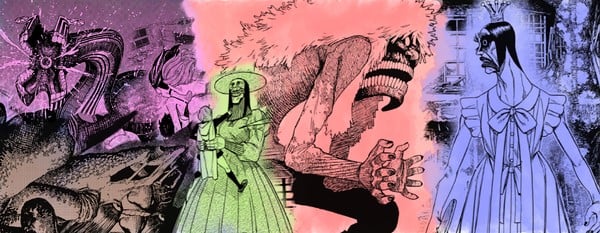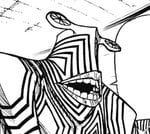The Real Yokai of DAN DA DAN
by Zack Davisson,
I was just at AnimeNYC, and as usual, after my yokai panel I had people curious about their favorite series, asking “Is this a real yokai?” I get that question all the time and the answer is always “Yes.” Because all yokai are real to the same extent that no yokai are real. Dealing with the realms of the imagination reality doesn't come into play.
What they truly want to know is if the monster in their manga has folkloric provenance. They want to know if the creature comes from whispered tales told at night and passed down by generations rather than the mere invention of an artist's pen. Somehow, this lends credibility. Yet as I explore in my book THE ULTIMATE GUIDE TO JAPANESE YOKAI many of Japan's most famous yokai come from an artist's pen.
In his Edo period book series HYAKKI YAGYO artist Toriyama Sekien is thought to have created around eight-five yokai. Well-known monsters like Wanyudo, a flaming monk's head stuck in a wagon wheel, are Sekien originals. Many more yokai come from books, plays, prints, and games—the only difference is that they were created two centuries ago. I don't think that is much difference at all. A yokai invented by masters like Shigeru Mizuki for his comic KITARO or Yukinobu Tatsu for DAN DA DAN are no less “real” for having been created in this century.
But it is still a fun question to ask. After all, if I didn't enjoy researching the roots of yokai I wouldn't have made the career for myself that I have. Tatsu has a particular taste for obscure urban legends which makes it all the more delightful. DAN DA DAN is full of rabbit holes to explore. The Flatwood Monster; the Count Saint-Germain…You can safely assume every oddity in DAN DA DAN has some bizarre history. Yukinobu Tatsu does his research.
Let's take a look at some of the most excellent monsters of DAN DA DAN and see if they have folkloric provenance.
• Gazan Daishi – The amulets used to repel and trap evil spirits are 100% authentic. You can buy them at temples across Japan. They feature the image of the 10th-century monk Ryogen, more commonly called Tsuno Daishi, meaning Horned Great Master, or Gazan Daishi. Ryogen was the 18th abbot of the famed Enryaku-ji temple and a master of the esoteric Tendai sect of Buddhism. The legend goes that he fell ill when attacked by the disease-causing plague gods, yakubyogami, so he manifested his oni-form to drive them away. This gave rise to his deification as Tsuno Daishi, and status as a hosogami, or deity invoked during epidemics to offer protection. Images of Gazan Daishi and another hosogami Shoki the Demon Queller were placed over doorways to frighten any yakubyogami that might want to infect a household. They are still used to this day.




• Earth-bound Spirit (Jibakurei) –Jibakurei comes from the comic Ushiro no Hyakutaro(Behind the Hundred Taros) by Tsunoda Jiro. Tsunoda used the word jibakurei to describe yūrei bound to something or somewhere instead of someone. Usually, these were unnatural deaths, such as suicide or murder. Tsunoda believed these deaths somehow linked the yūrei to their location. He said they projected a psychic resonance that caused others to die in the same manner, which is how suicide spots accumulate across Japan. In DAN DA DAN, this belief is merged with the Heikei Crabs. These are a species native to Japan famous for having a samurai face on their carapace. They are considered to be the reincarnation of the Heikei warriors who died during the battle of Dan-no-ura.
Zack Davisson is an award-winning translator, writer, and folklorist. He is the author of Manga: A Visual History, The Ultimate Guide to Japanese Yokai¸and Kaibyo: The Supernatural Cats of Japan. He is the translator of Shigeru Mizuki's multiple Eisner Award-winning Showa: A History of Japan, Tono Monogatari, and famous folklore comic KITARO. He lectured on manga, folklore, and translation at colleges such as Duke University, Annapolis Naval Academy, UCLA, and the University of Washington, and contributed to exhibitions at the Henry Art Gallery, The Museum of International Folkart, Wereldmuseum Rotterdan, and the Art Gallery of New South Wales. He currently lives in Seattle, WA with his wife Miyuki, dog Mochi, cat Shere Khan, and several ghosts.
discuss this in the forum (7 posts) |